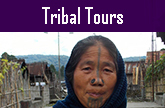Tripura Tourism
Tripura is the third smallest state of India surrounded by three sides, on the west, north and south. Assam and Mizoram lie to its east. Initially known as ‘Tuipra’, meaning “A land adjoining the water”, this state encompassed by hill ranges, valleys and plains is endowed with unique ethnic culture, abundant natural landscapes and magnificent temples & palaces.
Tripura : At A Glance
State Capital:
Agartala
Official Language:
Bengali and Kokborok
State Animal:
Phayre's Langur
State Bird:
Green Imperial Pigeon
State Flower:
Nageshwar
State Tree:
Agar
Number of Tribes:
19
Sex Ratio:
960 females for each 1000 males (Census Report of India, 2011)
Population Density:
350 per sq kilometer (Census Report of India, 2011)
Major Crops:
Rice, Sugarcane, Cotton, Jute, Mesta
Major Plantations:
Tea, Rubber, Coffee
Major Minerals:
Fire Clay, Quartz, Silica Sand
Geographical Location:
Longitude 90’E to 92’E & Latitude 22’N to 24’N
Area
Tripura encompasses an area of about 10,486 sq km with 8 districts falling within its territory.
Population
Tripura has a population of about 3,673,917 out of which 1,874,376 are males and 1,799,541 are females. (Census Report of India, 2011)
Literacy
The literacy rate in Tripura is 87.22%. Of that, the male literacy rate is 91.53% while female literacy is 78.98%. (Census Report of India, 2011)
Climate
Tripura possesses a hot and humid climate characterized by four main seasons --– winter (December – February), Pre- Monsoon or summer (March – April), Monsoon (May – September) and Post Monsoon (October – November). Average rainfall of the state ranges to 220 cm. There is heavy downpour during the monsoon season caused by the south-west monsoon which results in continuous flood in the state. Temperature during summer ranges from 24’ C to 34’ C, while in winter, it goes down to a minimum temperature of 13’ C.
Economy
Tripura has an agriculture based economy. The inhabitants of the state adopt agriculture and allied activities as the main source of livelihood. Service sector also adds to the gross domestic products of the state. Forests, encompassing about 57% of the area of Tripura, provide a greater contribution to the economy of the state.
History of Tripura
The state of Tripura is found mentioned in the Mahabharata, the Puranas and pillar inscriptions of Emperor Ashoka. The ancient name of Tripura is referred to as Kirata Kingdom or Kirat Desh. The region is said to be ruled by the kings of Tuipra Kingdom for centuries. Records of these reigns of the kings are not available. A chronicle of Tripuri kings, ‘Rajmala’, written first in the 15th century enlists a number of 186 kings from ancient history to the recent times.
The kingdom of earlier Tripura continued to extend during the reign of various kings reaching the boundaries of Sundarbans of the Bay of Bengal, the margins of Kamarupa Kingdom in the north and the borders of Burma in the west. Mughal attacks started threatening the kingdom from the 13th century. These invasions failed to curb the supremacy of the hilly area of the region, but the plains came under the Mughal authority in 1773 AD. At the time of British rule in India, Tripura was ruled by kings with Udaipur (present South Tripura district) as its capital by the bank of the river Gomati. In the 18th century, then ruler of Tripura, Maharaja Krishna Chandra Manikya Bahadur (1829 AD – 1849 AD) of Manikya dynasty transferred the kingdom’s capital to Old Agartala by the bank of river Howrah. In order to maintain quick access and smooth interaction with the British Bengal, the capital was finally shifted by Maharaja Krishna Chandra Manikya Bahadur to present Agartala in 1849 AD.
Tripura achieved its modern look with the planned city of Agartala during the reign of Maharaja Bir Bikram Kishor Manikya Bahadur (1862 AD – 1896 AD). He formed the Agartala Municipal Corporation thereby shaping the administration on the British India design within an area of about 7.8 sq kilometers. The descendants of this dynasty continued their rule over Tripura till 1947.
With the attainment of independence of India in 1947, the signing of the Tripura Merger Agreement on 9th September 1947 by the Regent Maharani of Tripura marked a new era in the history of Tripura with its annexation as Part C State of India. Tripura achieved the status of a Union Territory on 1st July 1963 and became a full fledged state of India on 21st January 1972.
Culture of Tripura
People
Tripura has a rich culture formed by the fusion of diverse ethnic groups. The tribal groups of Tripura comprises of 30% of the total population of the state. Tripuri community inhabits the state in large numbers. Noatia, Jamatia, Oraon, Chakma, Reang, Koloi, Murasing, Halam, Garo, Kuki, Lushai, Mogh, Munda, Mizo, Darlong, Santhal and Uchai constitute the tribal population of the state. The largest non tribal community of Tripura is the Bengali whose culture has influenced many elite tribal families residing in urban areas. Due to the absence of economic and educational development among the Reang tribe, they are still regarded as primitives. They also do not abide by any legal form of justice. The Chakma tribe, sub-grouped into various sections is ardent devotees of Buddhism. Halam community originated from sects of Kukis is the oldest residing tribe in the state even before the Tripuris came to this land. Initially, this tribe had 12 groups, but at present the number had increased to 16 clans. The unique social lifestyle and customs of the Lushai community deserves great attraction among the tourists.
Festivals
Music and dance predominates the various festivals celebrated in the state. Garia Puja is marked on the 7th day of the month of Baishakh celebrating for good fortune, prosperous harvest and enjoyment all the year round. Garia song and dance is performed by the Tripuri and Jamatia tribe during this festival in order to please their divine beings. Some of the traditional tribal festivals are Kharchi Puja, Ganga Puja and Ker Puja. Sarda Utsava is a famous festival organized and promoted by the Govt. of Tripura to ensue a rich cultural surrounding in the state. Durga Puja, Kali Puja, Ashokastami are some of the Hindu festivals celebrated in the state.
A famous dance of the Reang community, the Hozagiri dance is a unique dance form performed by the dancers gracefully twisting the lower part of their body without the use of hands or upper part, standing steadily on earthen pitchers. Bizu dance of the Chakma community symbolizes the greetings of the New Year and bidding of the previous year. Hai-Hak dance, Jhum Dance and Wangala dance are the well known harvest dances of Tripura performed with great enthusiasm and elegance. Lebang-Boomani dance, Mamita dance and Mosak Sulmani are some of the famous Tripuri dance forms which enhance grandeur to the celebration of the festivals.


















